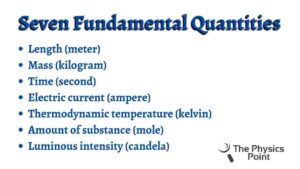What is SI Units? Definition, List, Importance and Full Form

Hello, how are you guys? I hope you all are fine. Today’s article, what is Si units are going to discuss physical quantities and their expressed units in the SI system Many of you somewhere hear about this system when you are in 9th class. But at that stage, you do not have a perfect always of system of units. So to make your concepts very clear in units and Measurement we bring back to you with a new article What is SI Units? From the point of understanding, this is a very fundamental topic of Physics and everyone must know about this because if our basics are clear then we can understand complex concepts easily way.
The important question which we are going to discuss today in our today’s article what is Si units and What is SI Unit, what is si units, what is si unit in physics, si units full form, what is a si unit, si unit chart representation, si system, si units list, si units table, what is si units definition, etc. From the exam point of view, these topics are very asked in board exams and in competitive exams in recent years. So read the whole article very carefully so that every concept of Physics must be clear in your understanding. For more information about the Physics subject, you can read our previous article also.
What is SI Units (Definition)?
SI unit is a system of units that is used to measure physical quantities. Si units are universally accepted and most used in technical and scientific research areas. The full form of SI is Système International. This is a very famous and widely accepted system of the unit and by the use of this unit, confusion is no more to measure the physical quantities because the whole world knows this SI unit system very well. SI system uses the MKS system in which M represents the meter, K represents the kilogram and S represents the second.

What are fundamental quantities?
The fundamental quantities are the quantities that cannot drive from other physical quantities is known as fundamental quantities. We can also state that the fundamental quantities do not depend on the other physical quantity they are unique itself. There are a total of seven fundamental quantities in Physics which are given below in the following table –
| S.no. | Fundamental Quantities | Units | Sign. |
| 1. | Length | m | m |
| 2. | Mass (M) | Kilogram | kg |
| 3. | Time (T) | Second | s |
| 4. | Electric current (I) | Ampere | A |
| 5. | Thermodynamic temperature (Θ) | Kelvin | K |
| 6. | Amount of substance (N) | Mole | mol |
| 7. | Luminous intensity (J) | Candela | cd |
- The length is measured in meters. it means the unit of length in meters. It is a fixed value and the SI unit of length.
- The unit of mass is the kilogram. And kilogram is the SI unit of the mass. It is defined by the Planck Constant by taking a fixed value. we represent the kilogram as a symbol kg.
- Second is the unit of time and it is also a SI unit of the system. It is defined by taking a fixed value of cesium frequency and it is expressed as s.
- Ampere is the unit of electric current and it is represented by A. It is a SI unit of current and it is defined wife taking the exact value or fixed value of the alimentary charge.
- The SI unit of Temperature is Kelvin. It is represented by K. It is determined by the taking fixed value of the Boltzmann constant. The value of Boltzmann constant k is 1.380649×10-23.
- The amount of substance is measured in moles. It is simply represented by mol. The SI unit of the amount is a mole. It is determined as the fixed value of Avogadro constant NA. Any substance of one mole contains 6.02214076×1023 elementary entities.
- The light intensity is measured in candela. It is Represented as a cd. A candela is a SI unit of light or luminous intensity.

SI Units List (Table)
This is an international System of units. In Physics all physical quantities have Si units which makes them easier to make quantitative analyses. The list of SI units is given below in the following table –
| S. No. | Physical quantities | SI Units | Symbol | Expressed in fundamental Units |
|---|---|---|---|---|
| 1. | Force, Weight | Newton | N | kg⋅m⋅s-2 |
| 2. | Frequency | Hertz | Hz | s-1 |
| 3. | Electric charge | Coulomb | C | s⋅A |
| 4. | Electric potential or Voltage | Volt | V | kg.m2.s-3.A-1 |
| 5. | Inductance | Henry | H | kg.m2.s-2.A-2 |
| 6. | Capacitance | Farad | F | kg−1.m−2.s4.A2 |
| 7. | Resistance, Impedance, Reactance | Ohm | Ω | kg.m2.s−3.A−2 |
| 8. | Electrical conductance | Siemens | S | kg−1.m−2.s3.A2 |
| 9. | Magnetic flux | Weber | Wb | kg.m2.s−2.A−1 |
What is the importance of the unit?
Unit is the basic thing in Physics when we measure any physical quantity we need two things the magnitude and the unit in which we represent the quantity like if you are taking your weight of yourself it is something about 60 kg. If we remove kg from your weight measurement, then it remains only 60 and we are unable to understand and what is the meaning of this 60. It may be 60 grams or 60 kg or 60 milligrams. So the unit is a very important factor in the Physics subject as well as other also. Thus we can say that without units we cannot give the right idea of any substantial quantity.
The Conclusion
So in today’s article what is Si units the study we talked about the various units of SI system in physics and we also talk about are fundamental quantities in our physics. Some important questions like si unit physics, si units of physics, si unit full form, and what does SI mean in physics are also discussed. We provide you with a table of SI quantities and fundamental quantities also. If you found this article help helpful you can also share this with your friends also so that they can also get benefit from this very awesome article. Thank You!
